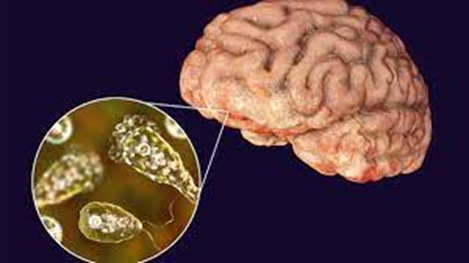Naegleria
infection
Overview
Naegleria (nay-GLEER-e-uh)
infection is a rare and almost always fatal brain infection. Naegleria
infection is caused by an amoeba commonly found in warm, freshwater lakes,
rivers and hot springs. Exposure to the amoeba usually occurs during swimming
or other water sports.
The amoeba — called
Naegleria fowleri — travels up the nose to the brain, where it causes severe
brain damage. Most people who have naegleria infection die within a week of
showing symptoms.
Millions of people are
exposed to the amoeba that causes naegleria infection each year, but only a
handful of them ever get sick from it. Health officials don't know why some
people develop naegleria infection while others do not.
Symptoms
Naegleria infection causes a
disease called primary amebic meningoencephalitis
(muh-ning-go-un-sef-uh-LIE-tis) — also known as PAM. PAM is a brain infection
that leads to brain swelling and the destruction of brain tissue.
The symptoms of naegleria
infection generally begin within two to 15 days of exposure to the amoeba.
Initial signs and symptoms often include:
Fever
Sudden, severe headache
Nausea and vomiting
Nasal congestion or
discharge
Changes in smell or taste
As the disease worsens,
signs and symptoms may also include:
Stiff neck
Sensitivity to light
Confusion
Loss of balance
Sleepiness
Seizures
Hallucinations
The disease can progress
rapidly and typically leads to death within about five days of the start of
symptoms.
When to see a doctor
Seek immediate medical
attention if you develop a sudden onset of fever, headache, stiff neck and
vomiting, particularly if you have recently been in warm, fresh water.
Cause
Naegleria infection is
caused by the Naegleria fowleri amoeba, which is most often found in bodies of
warm, fresh water around the world, especially during the summer months. The
amoeba is also sometimes found in soil. The amoeba enters your body through
your nose via contaminated water, mud or dust, and travels to your brain
through the nerves that transmit your sense of smell.
As states in the overview
only a tiny percentage of the millions of people who are exposed to Naegleria
fowleri ever get sick from it. Between 2010 and 2019, 34 infections were
reported in the United States. Why some
people become infected after exposure and others don't isn't known.
The amoeba doesn't spread
from person to person. You also can't be infected by drinking contaminated
water. Salt water, such as ocean and sea water, and properly cleaned and
disinfected swimming pools don't contain the naegleria amoeba.
Risk factors
Millions of people are
exposed to the amoeba that causes naegleria infection each year, but only a few
people get sick from it.
Some factors that might
increase your risk of naegleria infection include:
Freshwater swimming.
Most people who become ill have been swimming in a freshwater lake within the
previous two weeks.
Heat waves.
The amoeba thrives in warm or hot water. Infections are more likely to occur in
the summer months and in southern states but can also occur in more northern
states.
Age.
Children and young adults are the most likely age groups to be affected,
possibly because they are likely to stay in the water longer and are more
active in the water.
Nasal cleansing or
irrigation. Very rarely, infections have occurred in
people who used contaminated tap water to irrigate their sinuses or to cleanse
their nose during religious practices. To ensure that your water is safe for
sinus rinsing or ritual cleansing, don't use water straight from the faucet.
Use boiled or distilled water instead.
Prevention
The Centers for Disease
Control and Prevention (CDC) suggests that the following measures may reduce
your risk of naegleria infection:
Don't swim in or jump into
warm freshwater lakes and rivers.
Hold your nose shut or use nose
clips when jumping or diving into warm bodies of fresh water.
Avoid disturbing the
sediment while swimming in shallow, warm fresh waters.
Jan Ricks Jennings, MHA,
LFACHE
Senior Consultant
Senior Management
Resources, LLC
JanJenningsBlog.Blogspot.com
412.913.0636 Cell
724.733.0509 Office
May 23, 2022




No comments:
Post a Comment